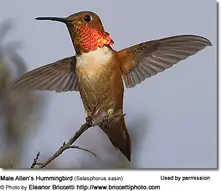Introduction
Quick Navigation
Hummingbirds are native to North America. They are found in Alaska, Illinois, Arkansas, California, and Missouri in the United States, and in southern British Columbia, southern Quebec, Edward Island, and Ontario in Canada. They also occur in Colombia, Ecuador, Cuba, Mexico, Belize, and Guatemala in Central and South America. Hummingbirds are migratory birds. In the United States, hummingbirds are a symbol of happiness and they represent an exciting start to a new day.
Species of Hummingbirds in Missouri and their Annual Migration Patterns
Anna’s Hummingbirds. This species of hummingbird are territorial in nature and they are relatively larger than other species of hummingbirds. They make elaborate dives at other birds especially during the breeding season and it is the only known species of hummingbirds that makes sound. Unlike most other species of hummingbirds, Anna’s hummingbirds rarely migrate from their range to spend cold season elsewhere. During winter, Anna’s hummingbirds are capable of going into a state called torpor – a state of inactivity similar to human sleep. Also, this species of hummingbirds is able to survive winter temperature by lowering their metabolic rates, converting sugar to fat.
Allen’s hummingbirds. It is the species of hummingbirds that is resident in coastal California. It can be identified by its distinctive green and black plumage. This species of hummingbirds is migratory. Allen’s hummingbirds travel southward as far as South and Central America from the onset of winter until the cold season is over. Usually, migration begins with males flying southward from late July until late September each year.
Ruby-throated hummingbirds. This species of hummingbirds is the earliest species to reside in Missouri[TEXT] reference[LINK]. It is the smallest of all hummingbird species. The species derived its name from the ruby throat of male members. Just like the Allen’s species, Ruby-throated hummingbirds winter in South and Central America where temperatures are higher. Migration away from the winter range occurs annually between August and October. They usually fly singularly with males taking the lead in the seasonal flight followed by females. They travel back to their breeding areas from April.
Rufous Hummingbirds. This species of hummingbird is popular for its fearlessness. Rufous hummingbirds commonly occur in gardens and at feeders. Their males can be distinguished from females by their glossy, orange-red throats. Just like the Allen’s species, Ruby-throated hummingbirds winter in South and Central America where temperatures are higher. Also, migration away from the winter ranges occurs annually between August and October. They usually fly singularly with male members taking the lead in the seasonal flight followed by female members.
Black-chinned hummingbirds. This species, among other species of birds[TEXT]reference[LINK] also occurs in Missouri. Their males have shimmering throat and pale-colored underside with purple edge while their females have back backsides. Black-chinned hummingbirds spend summertime in Texas, Missouri, Arizona, and coastal California. They fly southward to northern Mexico during winter months, beginning from August. Like Rufous hummingbirds, they are wide-ranging species.
Calliope Hummingbirds. This is the smallest species of hummingbirds in North America. Their plumage may have color variants between orange and red, and sometimes with white undersides, depending on their gender. This species of hummingbirds spends summertime in Texas, Missouri, Arizona, and coastal California. Members fly southward to northern Mexico during winter months. Like Rufous hummingbirds, Calliope hummingbirds are wide-ranging species.
Triggers of Hummingbird Migration and What Sustains them on their Journey
Essentially, hummingbirds are migratory birds, and very few species of them do not migrate throughout the year. On this premise, it is often debated in the birding community what induces the migration of hummingbirds. And beyond this, how hummingbirds are sustained on their long journey on an annual basis is a topic of common discourse. Several factors have been provided by different birders as to what stimulates hummingbird migration. Factors that explain hummingbird migration are as follows:
Duration of Daylight. One factor proffered to explain hummingbird migration is duration of daylight. Birders and birding scientists are of the opinion that hummingbirds, being diurnal birds, are sensitive to the duration of daylight. Hence, they are more likely to relocate from regions of shorter broad daylight to areas of longer daylight.
Availability and Abundance of food. Hummingbirds, like other animals, enjoy staying around food sources. Therefore, they tend to linger where food is readily available or abundant. When food supplies such as nectar, tree buds, and insects are in bumper quantities, higher population of hummingbirds is likely to occur there. On the other hand, as soon as food supply begins to diminish, lower and lower population of hummingbirds is likely to be encountered until the entire flock disappears from sight.
Intuition/instinct. This is another reason that birding experts have proposed for hummingbird migration. Birding experts claim that hummingbirds use their instinct to decide when to migrate from any one region to another. Of course, hummingbirds are instinctive birds. For example, they migrate from western and northwestern United States to northern and southern Mexico during winter to avoid the unfavorable winter season only to fly back at the onset of summer and spring when weather conditions are favorable. Also, hummingbirds use instinct to decide when flowers in an area that were once depleted of nectar would have rejuvenated and so they usually fly back for feeding.
As to the adaptability of hummingbirds for migration, birding experts found that the birds usually gain between 20 and 40 percent of their body weight before they embark on migration. By implication, the birds normally feed well prior to migration. Also, hummingbirds ease their journeys and make it faster too by using tail wind while flying. In addition, hummingbirds usually fly low during their long journeys to enable them sight and stop at flowers to feed. By this, hummingbirds renew their energy.
Conclusion
Hummingbirds are smart, intelligent birds that occur in North, Central and South America. However, hummingbirds are fraught with the need to migrate annually from North America to South America during the winter months. A more careful monitoring of the migration pattern of hummingbirds can help contribute to their multiplication by providing more feeders to re-energize them when they return to their breeding regions.
.

